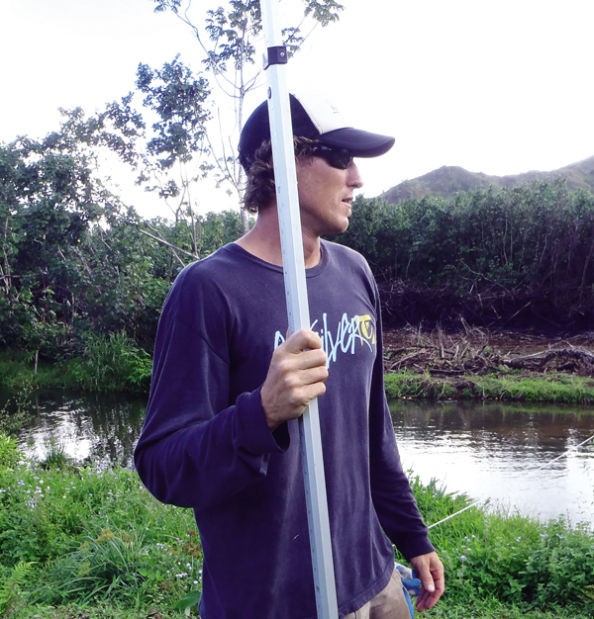In Waipa, on Kauai’s North Shore, many hands are working together for a better future of the ahupuaa. In 2011, the Waipa Foundation kicked off a project aimed at restoring an area of Waipa Stream, which has involved clearing invasive
In Waipa, on Kauai’s North Shore, many hands are working together for a better future of the ahupuaa.
In 2011, the Waipa Foundation kicked off a project aimed at restoring an area of Waipa Stream, which has involved clearing invasive species and replacing them with native plants.
This week, The Garden Island chats with project manager and hydrologist Matt Rosener about all the exciting things happening in Waipa, specifically the stream restoration, and his vision for the future.
“We have made a lot of progress on this unprecedented project over the last two years, and we’d like to get the word out about it as well as invite the public to come and volunteer with us,” he said.
For 20 years, Waipa Foundation has worked with the community to manage the ahupuaa of Waipa as a Native Hawaiian learning and community center where people can connect with the land and learn about local values and lifestyle.
“The 1,600 acre ahupuaa of Waipa … is one of the few ahupuaa in Hawaii that remain intact,” states the Waipa Foundation’s website.
Owned by Kamehameha Schools, the area has been managed by the community for over 30 years, beginning with the Hawaiian Farmers of Hanalei in the 1980s.
The Garden Island: First, tell our readers a little about your background and role with the Waipa Foundation?
Matt Rosener: My background is in hydrology and water resource engineering, and I’ve been working on watershed and stream issues in Hawaii for about 12 years now. My role at Waipa involves leading the stream restoration project, along with Kaipo Like, the restoration site manager.
I’m also coordinating water monitoring efforts and helping build capacity to manage water resources locally.
TGI: Can you describe Waipa stream prior to starting the restoration project there?
MR: Picture this — ankle-deep mud, dense tangles of hau bush branches, clouds of mosquitoes. The part of the stream that we’ve focused on was essentially a huge swamp before we started. The stream was plugged with debris and sediment, blocking fish passage and ruining spawning habitat for native fish species. It was a mess.
TGI: How is it looking now? How do you choose to describe the transformation?
MR: It’s night and day different. Cutting the invasive hau bush has revealed sweeping views of the Waipa ahupuaa. Opening the area to the wind and sun has caused the ground to dry up a bit. And the stream itself is much less stagnant. The hau has been replaced with a mix of native and canoe plants that are producing resources for the Waipa community already.
TGI: I understand that part of the project is monitoring water quality in the area. What changes, if any, have you seen?
MR: The monitoring component of the project is important to evaluate the project’s impact, both short- and long-term. We’ve generally seen increased dissolved oxygen levels in the stream since the work began, and decreased turbidity (murkiness) which are positive signs. We’re also doing snorkel surveys to count the fish.
TGI: What is the next phase of the project? What is the ultimate goal?
MR: Working along streams, you just never know when the next flood is coming. So we’re limiting the clearing work to the drier summer months, and only opening small areas at a time, to be conservative. Winter/spring activities include out-planting, maintenance and monitoring. The goal is a healthy stream corridor that provides resources and an educational venue for Waipa.
TGI: Can you talk a little bit about how the project provides educational and cultural opportunities?
MR: We’ve hosted all kinds of school groups at the project site, from elementary up to college level. We like to provide opportunities for students to learn about the watershed, usually in the hands-on style that is a Waipa trademark. Providing cultural context allows students to appreciate the significance of the ahupuaa system still being practiced at Waipa.
TGI: What about volunteering? Are you looking for people to help out?
MR: We’re always looking for volunteers! We hold volunteer workdays every other month. Contact Emma Stauber at (831) 566-4575 or emmaleah@hawaii.edu to RSVP and to get information about what to bring. Lunch is provided too!
TGI: How many volunteers do you think you have had over the years?
MR: We’ve had over 1,500 volunteers contribute more than 3,500 hours of time and effort to the project so far. We’ve been fortunate to receive some grant funding for the project from the U.S. Fish & Wildlife Service and Hawaii Community Foundation, but this whole effort would not be sustainable without volunteer support.
TGI: What do you personally love about the Waipa area?
MR: As much as Waipa’s natural beauty continues to amaze me, it’s the people of this place that make it so special. I’ve never been involved before with a group of such positive attitudes and personalities that seem to complement each other so well. There is always work to do at Waipa, but the synergy that exists amongst the people there usually makes it seem easy.
TGI: What is one thing most people don’t know about the work being done there that you think they should?
MR: Waipa is the perfect venue for blending traditional and modern styles of land and water stewardship. The Waipa Foundation is an organization that’s really at the leading edge of resource management in Hawaii, in my opinion, and it’s seen throughout the islands as a model to be followed.
For more information, visit www.waipafoundation.org or call 826-9969.
• Chris D’Angelo, environmental reporter, can be reached at 245-0441 or cdangelo@thegardenisland.com.




